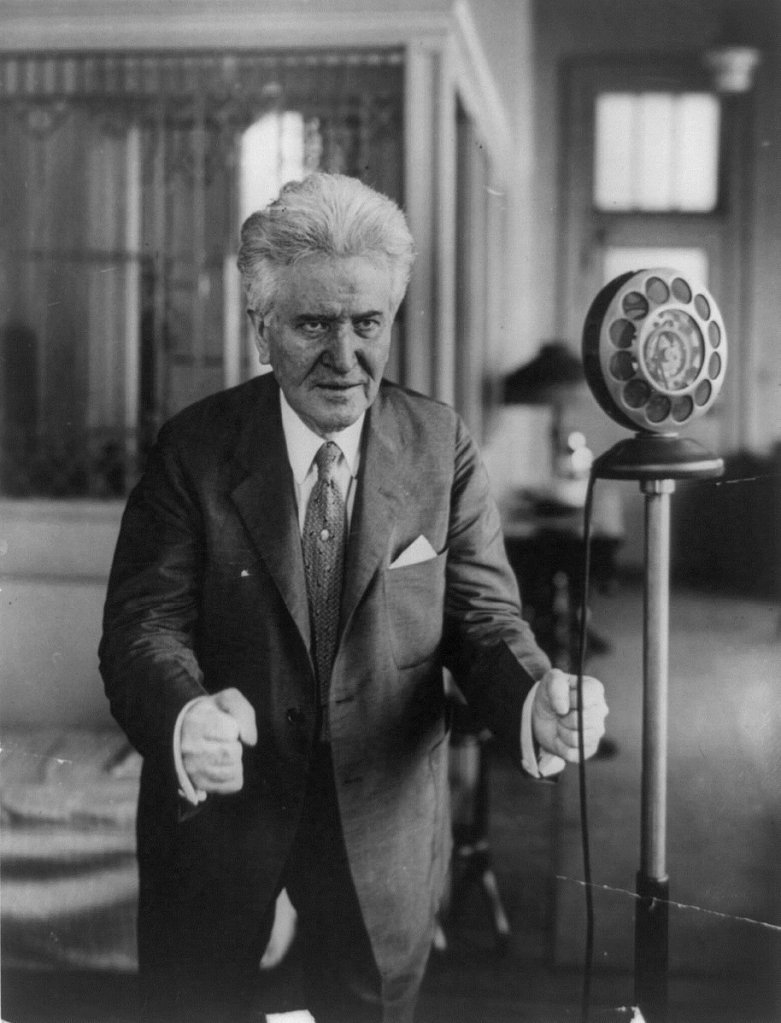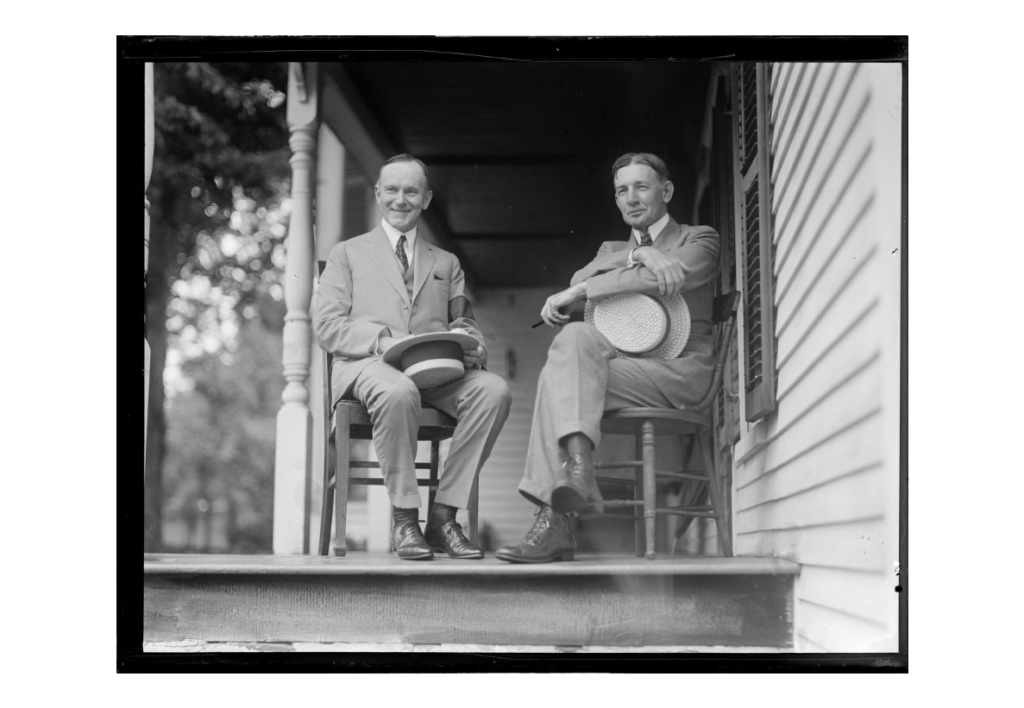
The old, feisty Senator from Wisconsin ventured out three times that fall. “Fighting Bob” LaFollette and his Progressives, personified in the papers as a bobcat scratching at the two major parties, had revived an issue from the 1912 campaign: an amendment to the Constitution that would create a popular veto against Supreme Court decisions. It had been one of TR’s recommendations in his speech before the Ohio Constitutional Convention, when he appeared on February 21, 1912, to address the delegates assembled to revise the state charter. In fact, TR had effusively praised the Senator and his work in Wisconsin in that speech and throughout the campaign that year. President Taft tried to counter the platforms of TR’s Bull Moose and, later that summer and fall, Wilson’s Democrats, with a rigorous speaking schedule to counter with his own message: How would it help the whole people in the short-term, not just those TR claimed to speak for, to introduce constitutional anarchy between state and federal authority and among the federal government’s branches itself? As Taft expressed it that October:
“After we have changed all the governmental machinery, so as to permit instantaneous expression of the people in constitutional amendments, in statutes, and in recall of public agents, what then? Votes are not bread, constitutional amendments are not work, referendums do not pay rent or furnish houses, recalls do not furnish clothing, initiatives do not supply unemployment or relieve inequalities of condition or of opportunity. We still ought to have set before us the definite plans to bring on complete equality of opportunity, and to abolish hardship and evil for humanity.”
If there was a political successor to TR twelve years later, however, it was neither Hiram Johnson nor George Norris, it was Bob LaFollette. While TR was reluctant to create an amendment that would itself be subject to the interpretation of the very judges under scrutiny, he wanted his proposal put into action only for close decisions, where a 5-4 rendering should not be considered “settled law” over and against a majority of the country’s wishes, as the Lochner case and others, state and federal had done in recent years. How that popular “recall” was to be done, he left to states like Ohio to sort out. “If there must be decision by a close majority, then let the people step in and let it be their majority that decides.” However it was going to be enacted, something had to be done, he urged.
LaFollette in 1924 suggested this remedy be placed in the legislative branch: “We favor submitting to the people for their considerate judgment a constitutional amendment providing that Congress may by reenacting a measure make it effective over a judicial veto.” Like that provided against the Executive veto in Article I, Section 7 of the Constitution, a similar Congressional act of repassing the bill over Court ruling would insulate it from further judicial review. This frontal attack on the independence of the third, co-equal branch of the federal government was one that very much animated the Republican Party. The top two partners on the ticket, Coolidge and Dawes, took aim at this proposed subordination of judges to legislators and the executive branch in Washington.

Ahead of LaFollette’s big address at Madison Square Garden on September 18 where he was set to promote the amendment platform before his largest crowd, Dawes had already pointed out its flaws on September 11:
“His proposition is in effect that no inferior Federal court be allowed to set aside an Act of Congress on the ground that it is unconstitutional, and that Congress may set aside the verdicts of the Supreme Court itself, if it declares unconstitutional a law which Congress may have passed. This proposition is to abrogate the principle of three-fold division of power…which is the basis of our Constitution.”
It would effectively, Dawes warned, undo the balance of three branches with one measure and place Congress in predominance over all others before it, the states included. It would potentially put every question of law, policy or social custom before a court of popular whims, already prone to provide immediate gratification to voters solicited every eighteen months. At the same time, it united with that tendency to constantly seek votes a supreme veto power immune from safe from anything the judiciary could decide in the future. There would no court of appeal beyond Congress, save perhaps the Executive, which would grow in consequence, but only as Congress allowed. It would be “disastrous.”
Coolidge, likewise, in dedicating the memorial to Lafayette in Baltimore’s Mount Vernon Place, had led the response on September 6:
Somewhere must be lodged the power to declare the Constitution. If it be taken away from the Court, it must go either to the executive or the legislative branch of the Government. No one, so far as I know, has thought that it should go to the Executive. All those who advocate changes propose, I believe, that it should be transferred in whole or in part to the Congress. I have a very high regard for legislative assemblies. We have put a very great emphasis upon representative government. It is the only method by which due deliberation can be secured. That is a great safeguard of liberty. But the legislature is not judicial. Along with that what are admitted to be the merits of the question, also what is supposed to be the popular demand and the greatest partisan advantage weigh very heavily in making legislative decisions. It is well known that when the House of Representatives sits as a judicial body, to determine contested elections, it has a tendency to decide in a partisan way. It is to be remembered also that under recent political practice there is a strong tendency for legislatures to be very much influenced by the Executive. Whether we like this practice or not, there is no denying that it exists. With a dominant Executive and a subservient legislature, the opportunity would be very inviting to aggrandizement and very dangerous to liberty. That way leads toward imperialism.

Coolidge was not done. He went on:
Some people do not seem to understand fully the purpose of our constitutional restraints. They are not for protecting the majority, either in or out of the Congress. They can protect themselves with their votes. We have adopted a written constitution in order that the minority, even down to the most insignificant individual, might have their rights protected. So long as our Constitution remains in force, no majority, no matter how large, can deprive the individual of the right of life, liberty or property, or prohibit the free exercise of religion or the freedom of speech or of the press. If the authority now vested in the Supreme Court were transferred to the Congress, any majority no matter what their motive could vote away any of these most precious rights. Majorities are notoriously irresponsible. After irreparable damage had been done the only remedy that the people would have would be the privilege of trying to defeat such a majority at the next election. Every minority body that may be weak in resources or unpopular in the public estimation, also nearly every race and religious belief, would find themselves practically without protection, if the authority of the Supreme Court should be broken down and its powers lodged with the Congress.
Coolidge would go on to win a sweeping victory that November, against two other candidates, which not only banished the spectre of 1912 for more than a generation, it rallied the country around a leader unafraid to defend the smallest minority, the individual, against the threats to silence and suppress them with realigned federal power. That was, in a truer sense than LaFollette’s bobcats or Davis’ Democrats realized, progress.
Remarkably applicable to our own day!